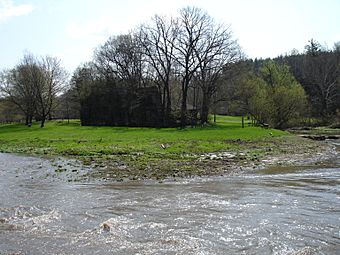Millville, Illinois facts for kids
Quick facts for kids |
|
|
Millville Town Site
|
|

Millville was located where the Apple River and the South Fork Apple River meet.
|
|
| Location | Apple River, Rush Township, Jo Daviess County, Illinois |
|---|---|
| Area | 25 acres (10 ha) |
| Built | 1835 |
| NRHP reference No. | 03000066 |
| Added to NRHP | March 3, 2003 |
Millville was a town that no longer exists in Jo Daviess County, Illinois. It was located inside Apple River Canyon State Park. The town was started in 1835 and planned out on a map in 1846. Sadly, a big flood in 1892 completely washed it away. Today, you can't see any buildings or signs of the old town. The place where Millville once stood was added to the U.S. National Register of Historic Places in 2003. It is known as the Millville Town Site.
Contents
Where Was Millville Located?
Millville was found in what is now Apple River Canyon State Park. Its exact spot is near the village of Apple River. The park has a deep canyon created by the Apple River. This happened when the river changed its path a very long time ago. The old river channel later filled up and became the South Fork Apple River.
Millville was built where these two rivers meet. A large rock and two special plaques now mark this historic spot.
Millville's Early Days
Millville began in 1835 along an important road. This road was the northern stagecoach route from Chicago to Galena. Today, it is called the Stagecoach Trail. John R. Smith and the Burbridge family built the first structures. A saw mill was set up between 1835 and 1836.
The town grew into a key stop for travelers and businesses. It was an important center for government and trade in Jo Daviess County from 1838 to 1853. The town itself was officially planned on April 14, 1846, by John R. Smith. This information comes from a history book published in 1878.
Why Millville Disappeared
Millville started to decline after railroads came to Jo Daviess County in the 1850s. The Illinois Central Railroad bypassed Millville in 1853-54. This made the town much less important. Still, two main businesses kept going into the late 1800s. These were a grist mill (for grinding grain) and a blacksmith shop. Maps from 1872 still showed the blacksmith shop, eight other buildings, two homes, and a school.
The town's end came with a huge flood in June 1892. Reports say the flood swept away all the remaining buildings. Heavy rains made the pond at Cox Mill, near Millville, overflow. The mill dam then burst. The water rushed down Clear Creek and into the South Fork Apple River. This powerful flood hit Millville, and the buildings could not stand against the rushing water. The town was completely washed away.
Life in Millville
By 1847, a large grist mill was built in Millville. It replaced the earlier saw mill. Other businesses also opened in this busy stagecoach stop. A man named Mr. Dean owned a blacksmith shop. John W. Marshall started a dry goods store. Another resident, Eldridge Howard, built a big house and opened a tavern inside it. At its busiest, Millville was the only important town between Freeport and Galena.
The main part of town was on the flat land next to the rivers. Other buildings were on the higher ground nearby. Millville covered about 25 acres and had around 10 blocks. These blocks were mostly laid out in a north-south grid. In 1840, the census showed 62 people living there. However, some local historians believe the population was closer to 330 in the late 1830s. This larger number likely included people from nearby farms.
The 1850 census helps us learn more about the people in Millville. It shows 27 households. We can also see where many of the family leaders came from and what jobs they had. Settlers came from 11 different states. Most were from Kentucky and New York. Only three people were born in Illinois, and one person was from another country. In 1850, 19 people worked in business or trade. 17 were farmers or laborers. At least 6 people worked in lead mining.
Exploring the Millville Site Today
Several archaeological surveys have been done at the Millville site. One survey happened when the Illinois Department of Transportation (IDOT) planned to replace a bridge. This bridge was over the South Fork Apple River in the state park. A team from the University of Illinois found a buried layer of soil. It was about 70-80 centimeters (about 2.5 feet) deep. This layer contained many 19th-century ceramic pieces and old building material. They also found an area of stone that might have been part of a building's foundation.
The team believed the bridge building would disturb the site. They suggested more study, but no other work was done. IDOT approved the bridge project in December 1991.
Today, the Millville site is open for visitors. It is marked by a plaque. People visiting Apple River Canyon can walk around the site and even have a picnic. However, using metal detectors and taking any old items (artifacts) are not allowed. The town site is protected by state and federal laws.
Why Millville is Important
Millville was a key town along the stagecoach route from Chicago to Galena. It played an important role in the early history of Jo Daviess County. The town site is very important for archaeology. Surveys have shown that the site is in good condition. Finding artifacts there in the future could teach us new things. We could learn about the daily lives of the people who lived in Millville. Because of these reasons, the Millville Town Site was added to the National Register of Historic Places on March 3, 2003.

